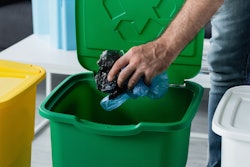
A recent article from Chemical & Engineering News, titled “Plastics recycling is in trouble,” presents a sobering analysis of the state of plastics recycling in the U.S. The article shows that many of the hopeful promises by brands surrounding plastic-waste recycling are now under strain and outlines why the problem is deeper than simple public sorting of bottles. It describes a system built on optimism but facing the hard limits of economics, infrastructure, and market demand.
As C&EN reports, nearly a decade ago, many of the world’s largest CPGs set ambitious goals to increase their use of recycled plastic and reduce reliance on virgin resin. Brands like Coca-Cola, PepsiCo, and Danone pledged to incorporate more recycled content into packaging, with several committing to targets as high as 50% by 2030. The article suggests that these promises reflected a period when many companies positioned recycling as a practical, publicly appealing way to address plastic waste without significantly reducing production. Now, as C&EN reports, those same commitments are proving difficult to meet, revealing how heavily the industry leaned on recycling as a fallback rather than a fundamental fix.
As the article makes clear, that strategy is unraveling. While companies are using more recycled plastic than they did a decade ago, many are falling short of their own deadlines. Some have extended timelines or scaled back targets, pointing to the high cost of recycled material and limited availability. Virgin plastic, made from abundant and inexpensive fossil feedstocks, remains far cheaper, creating a financial gap that has proven difficult to close.
The publication quotes Jan Dell, founder of the Last Beach Cleanup, who recalls that 2025 “was supposed to be the year that plastic recycling would show that it could work.” Instead, the year has arrived with disappointing results and an industry confronting its limitations.
Recyclers under mounting pressure
According to the article, the challenges extend well beyond corporate boardrooms. C&EN describes a recycling sector under mounting financial and operational pressure. MRFs and recyclers/reprocessors are facing shrinking margins and rising competition from virgin resin. Even in states with strong environmental policies, such as California, recyclers are struggling to stay open.
The article notes that several U.S. recycling facilities have closed in recent years, including plants in North Carolina and California. One company—r.Planet Earth—representing about 4% of the nation’s PET recycling capacity, has also gone out of business. These closures have ripple effects throughout the supply chain. When recyclers shut down, the flow of recycled resin tightens, making it even harder for brands to source material and meet their sustainability commitments.
The economic pressures are compounded by technical barriers. The article highlights that not all plastics can be easily recycled. Many products are made from mixed materials or contaminated with residues that reduce their value and recyclability. Sorting and cleaning these materials adds cost and complexity, further weakening the industry’s competitiveness against new plastics.
The feedback loop of decline
As C&EN explains, the recycling system is caught in a damaging feedback loop. Weak demand for recycled resin discourages investment in new recycling capacity. The lack of capacity, in turn, makes it harder for companies to meet their recycled-content goals, which depresses demand even further. Over time, this cycle has created an unstable market that struggles to attract long-term funding.
The article traces part of the current situation to China’s 2018 decision to ban imports of plastic waste. Before that ban, much of the plastic collected in the U.S. was shipped overseas for processing. The sudden loss of that outlet forced the domestic industry to expand quickly, often without the economic foundation to sustain growth. Since then, C&EN notes, more recyclers have shut down than have opened—a clear sign that the economics of recycling remain challenging.
Voluntary goals are not enough
The article emphasizes that voluntary corporate commitments alone are unlikely to solve the problem. Without consistent demand for recycled materials, recyclers cannot operate profitably. C&EN reports that the U.S. recycling rate for plastics remains below 10%, a figure that has barely improved since 2018, according to data from the Environmental Protection Agency. Despite years of corporate pledges, the national system still depends on cheap virgin plastic, limited sorting capacity, and fragmented local recycling programs.
Experts interviewed in the article argue that meaningful progress will require stronger policy measures. They point to examples from Europe, where governments have implemented recycled-content mandates, deposit-return programs, and extended producer responsibility (EPR) systems that hold manufacturers accountable for the packaging they create. Similar efforts are beginning to take shape in the U.S., though far more slowly.
C&EN reports that several U.S. states, including California, Oregon, Maine, and Colorado, have enacted or are EPR laws aimed at improving recycling and reducing packaging waste. These laws require producers to help fund the collection, sorting, and recycling of the materials they put into the market. California’s version, considered the most comprehensive, also sets targets for reducing single-use packaging and mandates that all packaging sold in the state be recyclable or compostable by 2032. Other states are developing similar frameworks, but national policy remains elusive.
According to the experts cited by C&EN, such policies could help stabilize markets by creating a guaranteed demand for PCR and by providing recyclers with predictable funding. Without them, they warn, the imbalance between low-cost virgin plastic and high-cost recycling will persist, and the ambitious sustainability goals set by major brands will continue to slip further out of reach.
A system out of sync
In its closing analysis, C&EN describes a recycling system that is fragmented and fragile. Collection programs vary widely from place to place, and contamination from mixed materials still limits the quality of recovered plastic. Recyclers remain squeezed by low prices and inconsistent supply, while brands struggle to secure the recycled material needed to meet their own commitments.
Rather than repeating calls for the same solutions, the article highlights the need for coordination across the entire plastics value chain. It points out that stronger policy alone will not be enough unless product design, manufacturing, and consumer behavior also evolve to support reuse and recycling. The publication emphasizes that the challenges are interconnected—economic, technical, and structural—and that they require a comprehensive approach rather than isolated fixes.
C&EN concludes that the potential for a circular plastics economy still exists, but realizing it will require sustained investment, clearer accountability, and collaboration among governments, companies, and recyclers. PW
Read the full article HERE.

























